Fifth International Congress of the John Gower Society
On the 8th July 2023, the University Libraries and Museums hosted an exhibit for the Fifth International Congress of the John Gower Society. We displayed 16 manuscript and printed items relating to the papers being delivered at the conference. The lively conversations held in Martyrs Kirk Research Library on that sunny Saturday were a true testament to the lasting influence the medieval poet has held throughout the centuries. The manuscripts reflected the literary and manuscript culture of Gower’s time and the books presented at the exhibition represented Gower and his writings’ journeys through the early modern period into the Victorian Medieval Revival. Alexa Zildjian received a grant from AMARC to help organise the display, to research captions and present the materials to delegates.
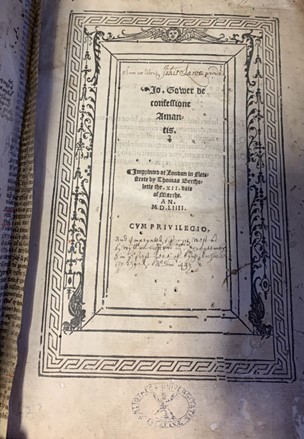
Our oldest example of Gower on display was the 1554 print edition of John Gower’s Confessio amantis (TypBL.B54BG), the last to be printed before the 19th century. In his dedication to King Henry VIII, the editor Thomas Berthelet also appears to be acutely aware of the importance of this text. He famously praises Gower’s use of English: “And though our most alowed olde autors did otherwhile use to borowe of other langages… to heape them in, where as nedeth not, and where as we haue all redie wordes approued and receiued, of the same effecte and strength.” With an eye to the future, however, Berthelet continues to discuss the significance of Gower’s text: “The whiche if any man wante, let hym resorte to this worthy olde writer Iohn Gower, that shal as a lanterne give him lighte to write cunningly, and to garnishe his sentneces in our vulagre tonge.” Berthelet was correct in his thinking: this rendition, possibly this same edition, would find its way into the hands of Shakespeare, Milton, Spenser, Dryden, and Coleridge.
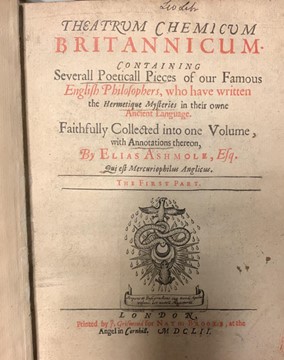
While another full rendition of the Confessio would not appear on English presses for many centuries, parts of it lived on. Our display included the first edition of the Theatrum chemicum Britannicum (AlcC52AS.EL), a compendium of alchemical literature. Editor Elias Ashmole envisions John Gower as a skilled user of the craft. In fact, he claims that Gower was Geoffrey Chaucer’s “Master in this Science,” training him in alchemy during their friendship. Excerpted in this book is a passage from Gower’s Confessio amantis, which Ashmole claims to prove Gower “fully understood the Secret, for he gives you a faithfull account… and affirmes the Art to be true.” While Ashmole’s main purpose with his inclusion of Gower is to illuminate the medieval author’s familiarity with the subject, it is interesting to interrogate Gower’s understanding of the meaning of alchemy. Ever living up to the epithet Chaucer gave him, Gower presents alchemy as a moral art. When practised correctly, it can bring its users philosophical wisdom and a closer relationship to God.
Towards the end of the seventeenth century and into the eighteenth century, Gower and his works appeared less often in print. However, in the midst of Romanticism and just at the start of the Nazarene movement, Reverend Henry J. Todd published his dual biographies, Illustrations of the lives and writings of Gower and Chaucer (s PR1910.T6). Todd details his process in the frontmatter of his book, outlining the care he took in generating his bibliographies. He sourced the manuscripts that build the bulk of his work from the libraries of the Marquis of Stafford and the Archbishop of Canterbury. There, he found a great volume of material, including Gower’s will. The timing of the publication could not have been better, however: the very same year, Alexander Chalmers reprinted Berthelet’ sedition of the Confessio Amantis, the first time the text had been printed since the 1554 edition. This was the beginning of Gower’s revival, one that would last through into the Victorian era.
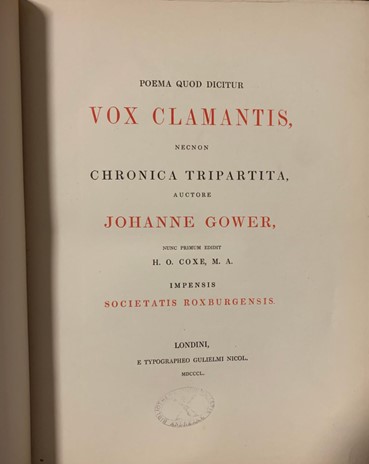
One such example Poema quod dicitur vox clamantis, nencnon chronica tripartita, which is an edition of John Gower’s Vox Clamantis and Chronica Tripartita (Lib Z1008.R6;69) that was produced for the benefit of the Roxburghe Club in 1850. This club is an elite organisation of bibliophiles built on a desire to find the most unusual, interesting, and rare texts. In order to join the club, a prospective member must offer up a small print run of a book published at their own expense. The editor of this volume, Henry Octavius Coxe, was at the time the sub-librarian of the Bodleian Library and a noted palaeographer. He held a strong interest in medieval literature and was himself ordained, two traits that would naturally bring him to the works of John Gower. Coxe would eventually become a member of the Roxburghe club in 1860, the same year he became the head librarian of the Bodleian.
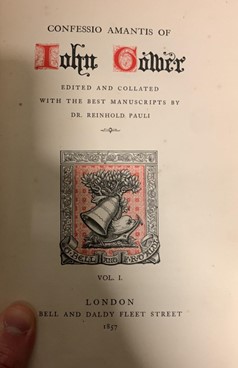
More Victorian art presses also took up the charge of printing Gower’s works, as demonstrated by the Chiswick Press’s 1857 Confessio amantis of John Gower edited and collated with the best manuscripts by Dr. Reinhold Pauli (s PR1984.C6E57). The private printing press was determined to bring artistry back into typography and print. While great care was taken in the physical production of this three-volume set, even more was placed in the generation of the text itself. Editor Dr. Reinhold Pauli notes in his introduction that the only other full edition of the Confessio is “a mere literal reprint of Berthelette’s edition of 1554.” To correct this course of simply repeating another printer’s editorial choices, Pauli referenced multiple manuscript editions of the poem to generate his edition. While Pauli also leaned on the Berthelet edition, he also heavily referenced the Harleian manuscripts held by the British Library.
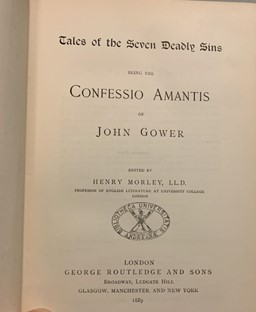
Gower had found a new home in elite circles of bibliophiles in England, but the most humble print run was what presented him to the English public once again. The 1889 Tales of the seven deadly sins : being the Confessio amantis of John Gower (r PR1984.C6) was edited by Henry Morley, a man who believed in the proliferation of good literature to the popular reader. He was the editor of both Morley’s Universal Library, the weekly publication Cassell’s National Library, and the longer, slightly more expensive Carisbrooke Library. These were all still relatively cheap volumes, with editions of Carisbrooke going for a half a crown. Considering the high praise Gower received, and continues to receive, for his use of English vernacular in the Confessio, its publication in the Carisbrooke series makes perfect sense. These longer, slightly more expensive volumes gave Morley more space to present books that might have been less accessible to the general reading public. Its mission was “…to bring home to Englishmen… some living knowledge of their literature along its whole extent, and of its relations with the wisdom and the wit of the surrounding world.”
Through these volumes, our guests were able to see how Gower was understood and transformed through time: from the press of Berthelet in 1554 to the hands of the English public in 1889, he and his works continued to influence English literature into our modern age.
Alexa Zildjian
PhD candidate, School of History
Conference research assistant thanks to grant from AMARC,
for which the University is most grateful https://amarcsite.wordpress.com/